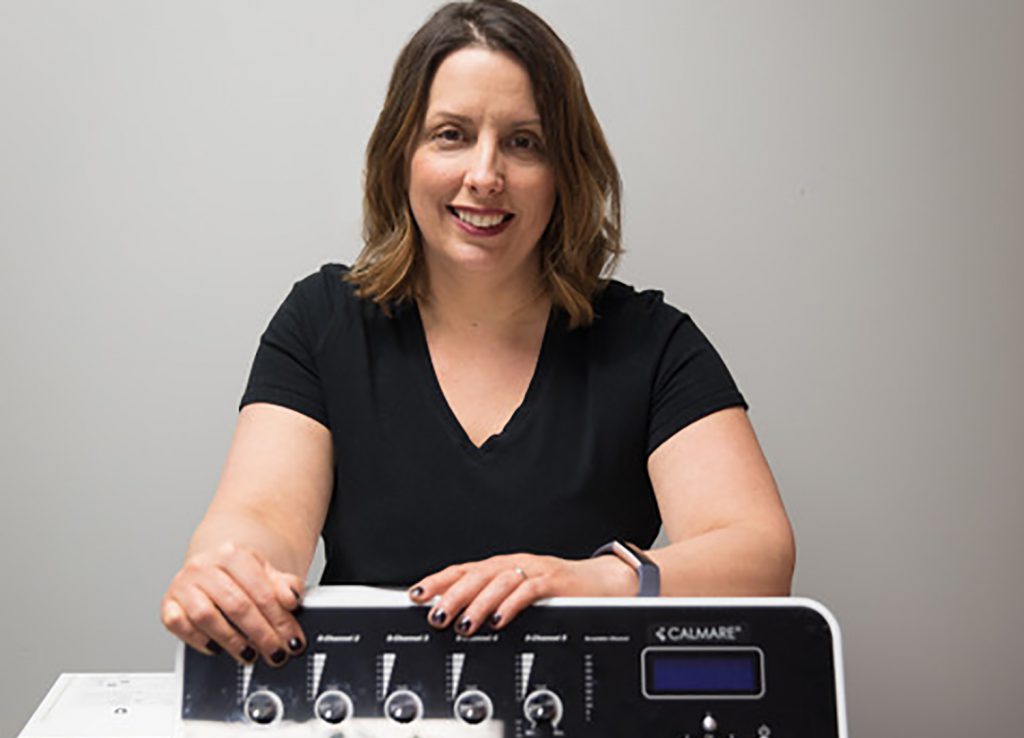
By Christine Graf
Clifton Park physical therapist and massage therapist Laura Brown is on a mission to help chronic pain sufferers eliminate their need for opioids. According to the National Institute of Health, 25 million Americans suffer from daily chronic pain and lack effective non-opioid treatments to manage that pain.
“I want to get people off the opioids and the narcotics. You can’t live on that stuff and you shouldn’t have to,” said Brown. “My mission is to give people a little bit of their life back.”
In order to help patients suffering from chronic neuropathic and oncologic pain, Brown purchased an $80,000 FDA-approved pain therapy device called a Calmare. The device delivers gentle electrical stimulation, and clinical studies have shown that its technology successfully reduces pain in more than 80 percent of treated patients without the adverse side effects commonly associated with drugs. It is not effective in treating pain caused by inflammation.
Brown first learned about Calmare from one of her massage clients, a physician whose daughter found relief from chronic pain after receiving Calmare pain treatment therapy. Intrigued, she set out to learn more.
“I saw that it didn’t just have a bunch of advertisements,” she said. “It had clinical studies and publications. Johns Hopkins uses it, the Mayo Clinic uses it, VA centers across the country use it.”
Because she is a physical therapist, Brown met the medical standard requirements necessary to become a Calmare practitioner and was able purchased the device in December 2019. Just as she completing the necessary training, the COVID shutdown forced her to close her office for three months. Since reopening, she is working to spread the word about the revolutionary pain treatment therapy she offers.
“It’s non-narcotic, it’s non-invasive, and there’s no pain or discomfort to the patient. It’s for people who don’t want to swallow any more pills and are trying to avoid surgery and are in pain every day and just want to get their lives back,” she said. “There are no side effects. The worst thing that can happen is that it doesn’t work, and we will know in the first session whether or not it will work.”
On average, a patient requires ten 60-minute treatments to achieve maximum pain relief. Treatments are not covered by insurance and cost between $200 and $250 per session.
“The national average is ten treatments, but some people are done in six. For some people it might be 12. It depends on the person, their diagnosis, the severity,” she said. “As for how long it’s going to last, I can’t tell you either. Maybe six months, maybe 10, maybe you never come back. For patients with stenosis, which is a structural problem—a narrowing of the spinal canal—I tell them not to expect full relief and that they may need a monthly booster.”
Calmare pain therapy treatment has been proven highly effective in treating pain associated with neuropathy, diabetic neuropathy, migraines, sciatica, phantom limbs, complex regional pain syndrome, failed back surgery syndrome, chronic cancer, and other neuropathic conditions. Brown mentions that some chronic pain sufferers have such heightened pain responses that they are barely able to tolerate wearing clothes.
The treatment does not help individuals suffering from inflammatory conditions such as arthritis or multiple sclerosis. Because she does not want to offer false hope, Brown requires prospective clients to receive a diagnosis from their doctor before beginning treatment.
Calmare therapy remains relatively unknown, and by the time a patient comes to Brown, they have usually attempted numerous alternative therapies without success. Many of these alternative treatments are very costly and have no clinical data to support them.
“People are spending a lot more money on things that aren’t even working,” she said. “No one’s heard of Calmare, so I’m usually the last stop.”
Brown is among the very limited number of independent practitioners to offer Calmere therapy. In many parts of the country, people must travel hundreds of miles to find a certified provider. Because of the treatment’s efficacy, she is surprised that more clinicians aren’t investing in the device.
“It might be that it sounds too good to be true and that people put in it in the ‘snake oil’ category. But it’s really not,” she said. “It’s the real thing, and there’s nothing to lose but your pain.”
Brown has more than 25 years of experience in physical therapy and massage therapy and also offers various types of massage at her 800 Route 146 office. She specializes in therapeutic massage which is helpful for individuals suffering from arthritis, migraines and other ailments.
“I can certainly do the Swedish spa-type experience, but that’s not what I’m there for,” she said. “Because I have PT experience, I’m there for people who have a problem or for people who have M.S or have had surgery or are post-cancer and are feeling a little bit scared to get a massage.”
For more information, visit www.calmaremassage.com.
